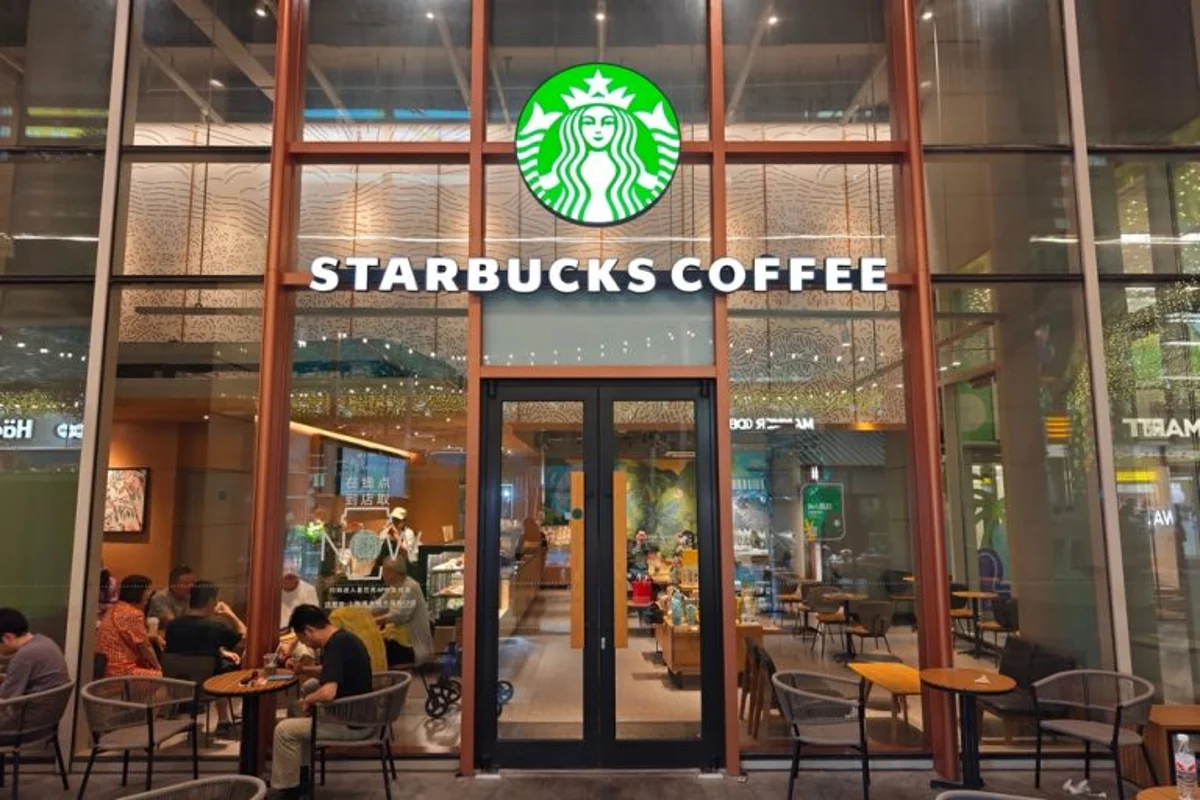By Ryan Peterson
Copyright benzinga

Analysts are saying that Starbucks could hit $61 by 2030. Bullish on SBUX? Invest in Starbucks on SoFi with no commissions. If it’s your first time signing up for SoFi, you’ll receive up to $1,000 in stock when you first fund your account. Plus, get a 1% bonus if you transfer your investments and keep them there until December 31, 2025.
Starbucks Corporation (SBUX) is pushing forward with strategic initiatives aimed at reigniting growth across international markets. Recent expansion in China and pricing strategies to offset rising input costs have kept the brand competitive despite global economic headwinds. Shares have reflected this pivot, trading in a narrow range as investors weigh the coffee chain’s near-term margin pressures against its long-term, loyalty-driven growth trajectory.
In this article, we’ll review Starbucks’ current price and valuation, examine price-target forecasts through 2030, analyze Wall Street’s latest sentiment, and break down the bullish and bearish outlooks shaping SBUX’s risk/reward proposition.
Current SBUX Stock Overview
Market Cap: $95.27 billionTrailing P/E: 36.28Forward P/E: 30.581 Year Return: -7%YTD Return: -6%
SBUX is trading close to $84, posting a mild decline over the last year and underperforming the broader market. The latest closing price is near its 52-week low, and a 52-week high of $117 marks a roughly 40% gap. Starbucks’ average price for the past year stood around $95, reflecting market concerns over operational cost pressures, same-store sales trends, and coffee commodity volatility.
During 2025, Starbucks has confronted margin compression from rising input costs, most notably coffee prices spurred by recent U.S. trade actions that triggered a 50% tariff on coffee from Brazil, which threatens to push Starbucks’ annual costs higher by around 3.5%, resulting in a projected $0.02 drop in EPS. Analysts and management cite supply chain reconsideration as a necessary response, especially given that Brazil is a primary coffee supplier for the U.S. Starbucks has navigated six consecutive quarters of declining same-store sales in the U.S., though global revenues grew by 4% to about $9.5 billion (surpassing expectations) even as operating margin dropped to 13.3%.
Wall Street sentiment on Starbucks is currently a Hold, based on the ratings of 28 analysts and an average consensus price target of $102. The most bullish estimate is $125 from Deutsche Bank, while Jefferies projects a low of $76. Recent updates from Baird, Guggenheim, and BMO Capital set price targets in the $107 range, indicating potential upside of 27% from current levels. The dispersion in ratings highlights both optimism about franchise growth and caution as ongoing cost challenges and market headwinds persist.
Quick Snapshot Table of Predictions
The forecast range in this table is based on algorithmic projections provided by CoinCodex. These models use historical price trends, volatility patterns, and moving averages to estimate future stock prices over multiple time horizons.
Bull & Bear Case
Starbucks faces a complex blend of global growth opportunities and operational risks, with changing consumer habits, regulatory fluctuations, and volatility in commodity costs affecting both outlook and valuation.
Global store expansion continues, particularly in China and Southeast Asia, supporting long-term revenue growth.Loyalty programs and mobile ordering adoption drive repeat business and increase ticket size.Premium beverage innovation and in-store experience differentiate Starbucks from competitors.Steady international revenue streams mitigate U.S. market risks.Upside targets from analysts reflect positive expectations for cost management and digital engagement.
Rising input costs from tariffs on Brazilian coffee threaten profit margins and could force price hikes on consumers, possibly restraining demand.Six straight quarters of declining U.S. same-store sales signal possible saturation or weakening domestic demand.Margin pressure is compounded by operating cost inflation and wage increases across major markets.Analyst sentiment is divided, and estimates for 2030 project only modest longer-term upside.Global commodity price swings add ongoing volatility to earnings and forecasts.
SBUX Stock Price Prediction for 2025
Forecast Range: $77 – $85
For the rest of the year, SBUX is expected to average $81, with a trading forecast between $77 and $85. Short sellers could see about 4% return on downward momentum. Coffee tariffs and associated margin pressures continue to weigh heavily, with further negative sentiment potentially leading to price volatility.
Ending the year, December’s average price could fall to $82, even as the max approaches $85. This would leave the stock close to flat compared to current values, reinforcing a bearish market for both value and short-term traders. Short sellers may see returns near 7% on predicted price trends.
SBUX Stock Price Prediction for 2026
Forecast Range: $51 – $85
Looking ahead to 2026, algorithms forecast Starbucks’ stock price to fluctuate between about $51 and $85, with an average trading level near $64. Modest growth could be seen in the first half of the year, with price strength projecting a minor gain of about 1% from today. The most bullish scenario is reviewed for January, where prices could reach $85, possibly reflecting post-holiday sales strength and loyalty program expansion.
Downside risk remains high throughout the year due to ongoing challenges with U.S. tariffs on Brazilian coffee, competitive pressures, and same-store sales trends. Supply chain adaptation and international market resilience remain critical to pushing toward upper forecast targets.
SBUX Stock Price Prediction for 2030
Forecast Range: $37 – $61
Forecasts for 2030 predict a bearish trajectory for Starbucks, with the price expected to fluctuate between about $37 and $61. Investors could see a potential ROI near 27% in the best scenario, though price momentum is expected to be moderate. If cost inflation persists and margins remain thin, SBUX could drift toward the lower end of forecasts. If consumer demand and commodity price trends improve, though, more optimistic targets might be achievable.
Bearish sentiment for 2030 highlights market doubts about significant expansion or margin recovery in the medium-to-long term. Investors seeking growth will need to monitor shifts in tariff policies and input costs, as well as Starbucks’ ability to evolve its menu, store format, and brand value proposition.
Investment Considerations
Tariffs remain a major impediment on Starbucks. The newly imposed 50% tariff on Brazilian coffee (America’s primary coffee source) threatens to raise input costs by up to 3.5% annually and has already contributed to declines in operating margin and earnings per share. This supply chain challenge may prompt the company to raise retail prices or accelerate shifts to new sourcing strategies.
Continued competitive pressure in both domestic and international coffee markets must be considered as well. Starbucks is navigating declining U.S. same-store sales and faces threats from boutique rivals as well as resurgent fast-food outlets advancing their own beverages. Still, the company’s loyalty program and technological integration offer some insulation, while international expansion provides diversification benefits.
Macroeconomic trends will impact both commodity costs and consumer discretionary spending. Rising interest rates, wage inflation, and supply chain disruptions are ongoing risks. Investors should watch for any policy shifts as well as the company’s capacity to innovate and maintain premium positioning. Monitoring analyst ratings and quarterly financial disclosures can help gauge future resilience and upside potential.
Frequently Asked Questions



